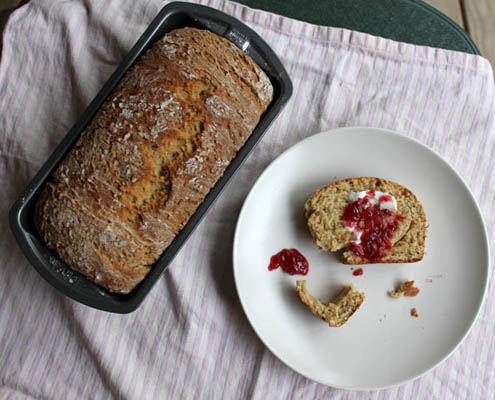Brittany Thomas is a freelance food writer and the author,…
Brittany Thomas is no quitter – and finally she is able to declare victory over yeast.
Text And Photo By Brittany Thomas

I have a long, torrid relationship with yeast. I don’t mean that in a sexy way, as if we were star-crossed lovers, destined to forever pass each other by the most improbable of circumstances. I mean that yeast has been the culprit behind most of my major kitchen failures – that challah bread that never rose more than a centimeter despite my coddling and pleading; the brioche au chocolat that seemed to be going well until I realized I made a calculation error and ended up with mostly brioche and minimal chocolat; or the Portuguese sweet bread that looked deceptively delicious but wasn’t worth the effort in the end – the common perpetrator is forever yeast.
Now, I’m no quitter, so I’ve continuously tried my hand at bread baking time and time again, yet the yeast conquers me every time. I’ve tried different brands, new recipes, and varying techniques. I checked out every self-help book in the I Hate Yeast But It Doesn’t Have to Be That Way section of my local library. My efforts have consistently been in vain.
One of the driving factors behind the madness is the insistence of most recipes that you “feel” your way about the dough. Now, I am all for feeling our feelings, but it’s quite impossible to know how something ought to look or feel when you’ve never had success with it, especially when it comes to quantities that are often less than helpful, like an ingredient list that reads “4-6 cups of flour.” There is just entirely too much room for error with a margin like that.
Lately, I’ve become more and more discouraged when it comes to yeast baking. I used to be all bright-eyed and bushy-tailed about it, making notes as I went and trying to figure out what went wrong so I could tweak it for next time. But after multiple flops, I was waving my little white flag of surrender from behind the kitchen island, covered in flour and despair. But this past weekend, I’m not sure what came over me, but I marched into the kitchen with a crazy look in my eye and pulled out my King Arthur Flour Cookbook. I don’t use it very much, and after flipping through it, I’m not sure why because it’s loaded with smart tips and quality recipes, and I turned to the recipe for Honey Oat Bread. My palms were already sweating at the prospect of it; just thinking about twisting the top off the jar of yeast makes my nervous system kick in.
Holding my breath the entire time, I kneaded and mixed and floured and rolled until I had two perfect little almond colored loaves resting on my back porch for their second rise. Feeling incredibly proud already, I re-read the directions for baking and was instantly stumped. It said to put the loaves in a cold oven and heat it to 400 degrees F for 15 minutes. Did that mean 15 minutes after it hits 400 degrees or 15 minutes from the time I put it in the cold oven? Fortunately, the lovely people at King Arthur Flour have a baking hotline for dilemmas like this and they set me on the straight and narrow.
Now I am careful to never proclaim victory over yeast until after I’ve tasted it, after all, I’ve had countless yeasted treats look and feel just perfect, only to pop them in my mouth and immediately want to spit it back out. So I smeared a bit of soft butter and a nudge of raspberry jam onto a slice of the bread after it had cooled a bit, closed my eyes and took a bite. It was dense at first, and I mean that in a very good way, a bit chewy with a tightly woven crumb and little nubbly bits of oats freckled throughout the loaf. The crust isn’t terribly thick, but it’s just craggy enough to require an extra chew. I took another bite, and then cut myself another slice, then another until I realized I’d eaten nearly half the loaf and declared victory.
PrintHoney Oat Bread
5 Stars 4 Stars 3 Stars 2 Stars 1 Star
No reviews
- Author: Brittany Thomas, Adapted from The King Arthur Flour Cookbook
- Total Time: 3 hours 15 minutes
- Yield: 2 loaves 1x
Description
An easy bread recipe sweetened with honey and oats for those of us with an irrational fear of yeast.
Ingredients
Oat Mixture
- 1 1/2 cups (12 oz.) boiling water
- 1 cup (8 oz.) rolled or steel-cut oats
- 1/2 cup (4 oz.) honey
- 4 tablespoons unsalted butter
- 1 tablespoon kosher salt
Dough
- 1 tablespoon active dry yeast
- 1/2 (4 oz.) cup warm water
- 1 teaspoon honey
- 3 cups (25 ounces) white whole wheat flour
- 2 1/2 cups (20 oz.) all purpose flour
Instructions
- Prepare the oats: In a large mixing bowl, mix together the oats, honey, butter, and salt. Pour the boiling water over the mixture and stir to combine. Set aside to cool to room temperature.
- Proof the Yeast: In the bowl of a stand mixer fitted with the dough hook, dissolve the yeast in the 1/2 cup (4 oz.) of warm water and honey. It should fizz and bubble up after a few minutes. Add the oat mixture to the bowl and stir until just combined. Add in the flours.
- Mix on low speed until the flour is completely incorporated and the dough forms a ball – about 7 minutes. Turn the dough out onto a floured work surface and knead it a few times. It should be smooth and soft. Shape the dough into a ball and place it in a lightly-oiled bowl (make sure it’s a large bowl so your dough has room to rise). Cover the top with a damp towel or plastic wrap and allow it to rise in a warm place until doubles, about 90 minutes.
- The dough is ready when you press two fingers into it and it doesn’t spring back. Tip the risen dough out onto a floured work surface and gently press it down to deflate it. Shape the dough into two loaves and place them in two 8 1/2x 4 1/2 (or thereabouts) loaf pans. Cover the pans with plastic wrap and let them rise a second time, about 45 minutes.
- Put the loaves in a cold oven and set it to 400 degrees. Set the time for 15 minutes and then reduce the temperature to 350 degrees and bake for another 25 minutes. (My oven is slow to heat, so it never reached the full 400 degrees before it was time to drop the temperature – this is okay.)
- The internal temperature of the bread should be 190 degrees F when it’s ready. Allow the bread to cool for about 15 minutes before slicing. Serve with soft butter and jam.
- Prep Time: 2 hours 30 mins
- Cook Time: 45 mins
Brittany Thomas is a freelance food writer and the author, photographer, & publisher of the award-winning blog "If You Give A Girl A Cookie." Her writing has been featured in The Urbanite, Hagerstown Magazine, The Baltimore Sun, & The Frederick News Post. She likes chocolate cake, asparagus, blood oranges, and lemon desserts. She lives in small-town Pennsylvania with her new husband and mischievous puppy, Kona.




white whole wheat flour? does that mean half and half or just plain white flour? can i sub bread flour?
King Arthur Flour makes a type of flour called White Whole Wheat – it’s a lighter version of whole wheat flour. I found mine at the regular grocery store, so it’s not a specialty item. If you can’t find it, you can substitute regular whole wheat but your bread will be a bit more dense.
Here’s what you’re looking for: http://www.kingarthurflour.com/shop/items/king-arthur-white-whole-wheat-flour-5-lb
Please let me know if you’re looking for a article writer for your site. You have some really good posts and I feel I would be a good asset. If you ever want to take some of the load off, I’d absolutely love to write some material for your blog in exchange for a link back to mine. Please send me an e-mail if interested. Thanks!